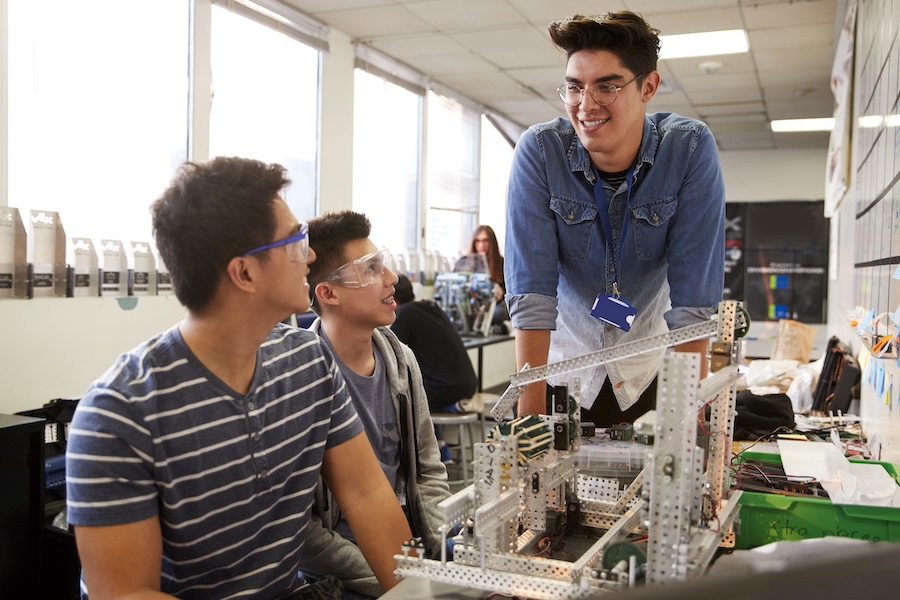When you apply to a college, they like to see concrete examples of your interests and passions. Getting good grades is nice, but a student who does nothing but study all day is a bit dull. Instead, they want to see students who have actively explored their interests, especially when those interests relate to whatever subject they plan on studying in college.
This is especially true for students interested in studying engineering. Engineering is one of the most competitive majors at major colleges, because there are a lot of students who want to partake in the major. Setting yourself apart from this group is important, as this is often the difference between acceptance and rejection.
But how do you do this? There are many viable ways, and no single silver bullet. In this article, we’re going to discuss one such way: engineering competitions. AFter all, winning a competition and getting third party confirmation that you really are great at engineering looks pretty good on a resume. We’ll break down some of the top engineering competitions for high school students, and explain how you can get involved. Let’s jump right in!
Regeneron International Science and Engineering Fair (ISEF)
Frequently referred to as Regeneron or ISEF alone, this is one of the largest pre-college science and engineering competitions, drawing students from around the world. There is a $25 registration fee to participate.
Students begin by competing at a state, regional, or local fair, and progress from there, with the top participants moving on to the next level. Depending on your location, there may be one or two rounds before you proceed to the international competition.
Projects for ISEF must be in one of their 22 registered categories. They realize that many projects may qualify as more than one category, you should pick whichever one best fits your particular project. Note that not all categories may be available at state or local fairs. Your choice of category will impact who judges your project, as judges are selected based on their expertise with a particular category.
Winning students receive awards based on their placement within their category; further prizes are selected from among the first place finishers. Prizes include both cash awards and scholarships.
Samsung Solve for Tomorrow
This contest is somewhat different, as it is generally run by teachers and completed by students. A teacher applies to have a class compete, and then the students take on the engineering challenge of that year’s contest. This is only open to schools which are at least 50% publicly funded, and to students in grades 6-12.
There are both state and national competition rounds; winners at the state level get a small prize and proceed to the next round of the competition. Prizes include cash awards and technology, both of which are meant to aid the teacher and school in educating more students. This is always a team event, with groups ranging from 4 to 60 students competing on one team.
NASA Human Explorer Rover Challenge (HERC)
Sponsored by NASA (surprise!), this contest challenges students to design and build (and race!) rovers meant to explore extraterrestrial terrain. The event is held annually in Huntsville, Alabama, with teams competing from around the country.
Both high school and college teams are eligible to compete. Students must first submit a proposal; if this is accepted, they will be invited to actually build their design and compete. The specific details of the challenge, including the route and any additional tasks teams will need to complete, vary from year to year.
There are no major prizes for this one, though design elements from winning teams may be incorporated into future NASA designs.
American Rocketry Challenge
NASA’s Jet Propulsion Laboratory was founded after a group of graduate students at Caltech almost burned down a barn experimenting with homemade rocket fuel. The American Rocketry Challenge continues this legacy (though unaffiliated), by welcoming students to build and launch homemade rockets each year.
There is an $85 fee to register a team. There is a strict schedule to follow for teams of students, and two rounds of competition. Rockets must meet certain benchmarks to qualify for the national round. Both middle and high school teams are eligible to participate.
Prizes are awarded to the top placing teams, with supplemental prize categories for marketing and presentation. The competition is sponsored by the aerospace industry.
Tests of Engineering Aptitude, Mathematics, and Science (TEAMS)
This is an academic competition, akin to academic decathlon, where teams of students complete a series of tests and challenges. There are three portions, an essay, a multiple choice test on engineering applications, and a design section, where students create a solution to an engineering challenge.
The competition takes place at the regional and then national level, with teams who succeed locally going on to the next level. There is a $150 registration fee required per team. There are two competition brackets; one for middle school, and one for high school.
Teams may consist of 2-4 students, and must have an adult acting as their coach. Coaches may have more than one team of students, but students may only be on one team apiece. The prizes are certificates and awards.
Shell Eco-Marathon
This is a multifaceted competition, where teams try to design and build cars which get the greatest possible fuel efficiency, or which run entirely off of renewable resources. Sponsored by Shell, there are regional competitions across the globe, held at different dates. This competition is free to enter.
The rules are updated every year, and eligibility requirements often depend on the region of the participating team. High school teams are allowed to compete, but are somewhat rare, due to the technical knowledge and level of resources required to compete successfully.
Rube Goldberg Machine Contest
In honor of the famous cartoonist and his fanciful contraptions, this contest assigns a simple task (the 2025 one is: feed a pet), and asks them to design and build a machine to do so in a highly complicated and convoluted manner. All machines must both complete the task at hand, and fulfill the spirit of the competition. This is not a project with a base in efficiency.
Teams compete locally or regionally live; winners are then selected to compete nationally, where you may compete live or digitally. There are different divisions, and students from elementary school through college are allowed to compete. Teams are allowed to enter from across the globe.
Prizes are general small cash awards, or merch from the Rube Goldberg association. This is a less serious competition, but lets you apply a great deal of creativity to solving a problem without the constraints of efficiency or reason.
Bridge Building Contest
Illinois Tech runs this competition, which challenges students to make the most efficient bridges possible out of balsa wood. This contest is free to enter, and has regional competitions leading up to an international round. The contest is run by the International Bridge Building Committee.
If you are not in an established region, or if your school does not participate, they encourage you to get involved. This competition is not as popular or well known as some of its fellows, but is quite reputable, and a valuable resource for students interested in civil or materials engineering.
Final Thoughts
This is not an exhaustive list of the engineering competitions out there, but a broad sampling, with the idea that one or more of them may appeal to your interests and fit in with your strengths. Engineering is a broad field, with multiple disciplines within it, and the variety of engineering competitions available to students reflects that.
Of course, there are many possible ways to show your interest in engineering to colleges, and competitions are just one of them. If you are interested in exploring more opportunities, but don’t know where to begin, schedule a free consultation with us today. Our candidacy building service helps students explore their passions in great depths, and we love helping students reach the height of their abilities.








